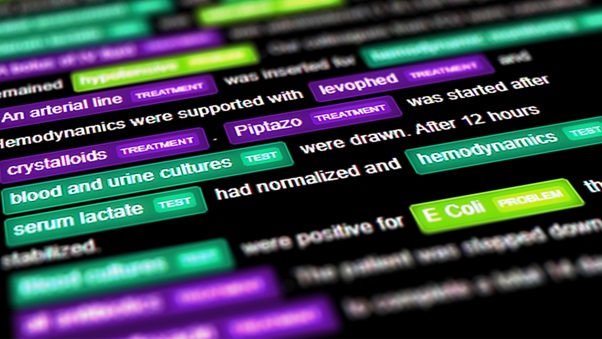BioNLP is a specialized field of Natural Language Processing (NLP) that focuses on applying NLP techniques to the vast and complex realm of biomedical texts. These texts encompass a wide range of resources, including:
- Scientific publications: Research papers, articles, and reviews covering various aspects of biology, medicine, and healthcare.
- Clinical data: Electronic health records, patient notes, and medical reports.
- Biological databases: Gene banks, protein databases, and other repositories of biological information.
Here’s how it works:
BioNLP utilizes NLP techniques to extract, analyze, and interpret valuable insights from these vast troves of biomedical information. Some key tasks within BioNLP include:
- Named Entity Recognition (NER): Identifying and classifying entities of interest in biomedical texts, such as genes, proteins, diseases, drugs, and chemical compounds.
- Relationship Extraction (RE): Identifying relationships between entities, such as protein-protein interactions, drug-disease relationships, and gene regulatory pathways.
- Text Summarization: Generating concise summaries of scientific papers or clinical reports for quick comprehension.
- Question Answering: Answering biomedical questions posed in natural language, enables researchers and clinicians to retrieve relevant information efficiently.
- Information Retrieval: Searching and ranking biomedical documents based on their relevance to a specific query or topic.
Importance:
BioNLP plays a crucial role in advancing various areas of biomedical research and healthcare:
- Drug discovery and development: Identifying potential drug targets, analyzing clinical trial data, and predicting drug side effects.
- Personalized medicine: Tailoring treatment plans for individual patients based on their genetic makeup and medical history.
- Public health surveillance: Monitoring disease outbreaks, identifying risk factors, and informing public health interventions.
- Medical knowledge management: Organizing and summarizing vast amounts of biomedical information for efficient access and utilization.
The Future of BioNLP:
The field of BioNLP is rapidly evolving, fueled by advancements in NLP technologies and the ever-growing volume of biomedical data. Some exciting trends shaping the future of BioNLP include:
- Integration with Artificial Intelligence (AI): Machine learning and deep learning methods are increasingly being used to improve the accuracy and efficiency of BioNLP tasks.
- Focus on clinical applications: BioNLP tools are being developed for direct integration into clinical workflows, supporting diagnoses, treatment decisions, and personalized medicine initiatives.
- Handling unstructured data: Expanding the scope of BioNLP to analyze unstructured data such as clinical notes and social media posts, providing a more holistic view of healthcare information.
Overall, BioNLP holds immense potential to revolutionize the way we understand, analyze, and utilize biomedical information, ultimately leading to improved healthcare outcomes and a healthier future for all.


